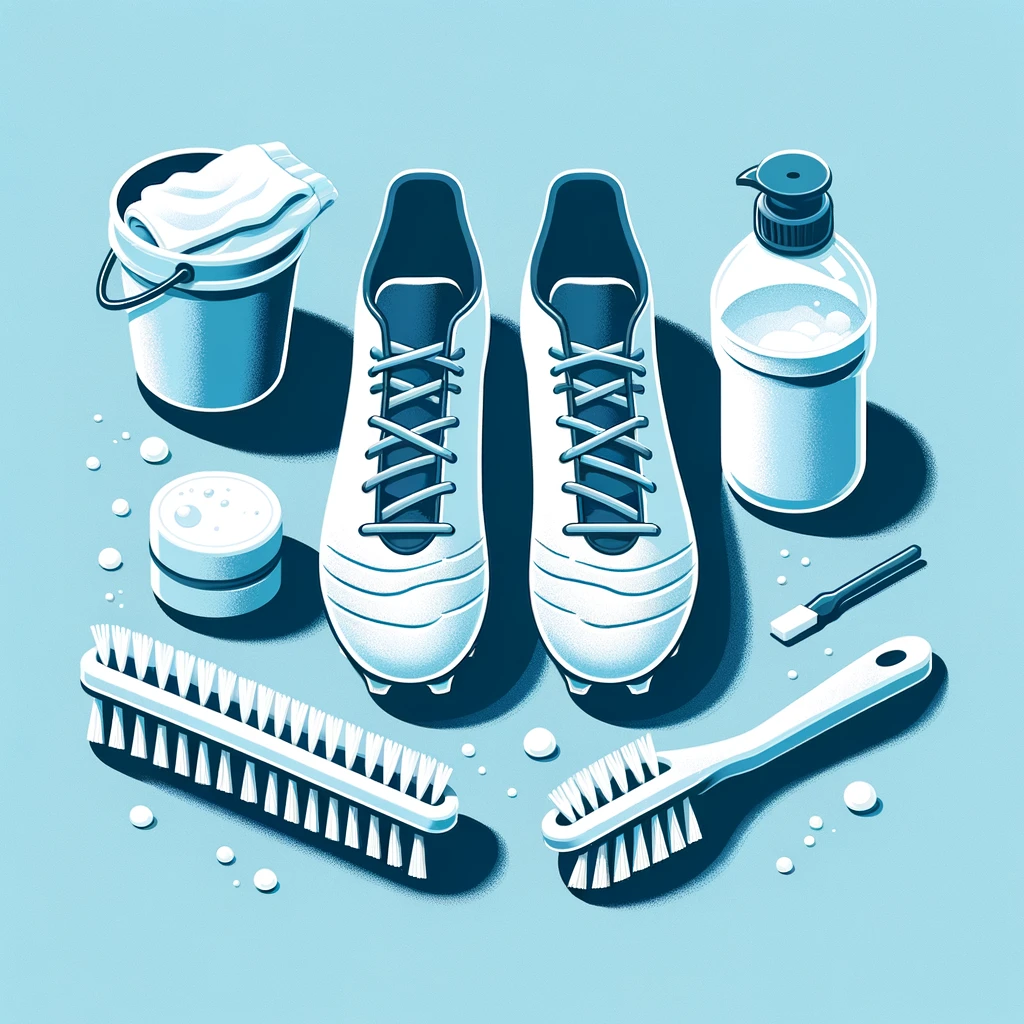Keeping your soccer cleats clean is crucial for preserving their quality and ensuring they last as long as possible. Dirt, mud, and grass can not only affect the appearance of your cleats but can also degrade the materials over time. Follow this comprehensive guide to clean your soccer cleats effectively.
Introduction
Soccer cleats endure a lot of wear and tear, facing harsh conditions on the pitch. Regular cleaning after games or practice sessions can prevent damage and keep them in good shape. This guide will take you through the steps to clean your soccer cleats properly.
What You’ll Need
- Lukewarm water
- A soft brush (an old toothbrush works well)
- A cloth or sponge
- Mild soap or a specialized cleat cleaner
- A bucket or basin
Step-by-Step Cleaning Process
Remove Loose Dirt and Debris
Knock your cleats together to remove any loose dirt. Use a soft brush to gently scrub away remaining debris. Avoid using a hard brush as it can damage the material.
Prepare Your Cleaning Solution
Fill a bucket or basin with lukewarm water and add a small amount of mild soap or specialized cleat cleaner. Avoid using hot water as it can damage the cleats.
Clean with a Cloth or Sponge
Dip a cloth or sponge into the soapy water and wring it out so it’s damp, not dripping. Gently wipe the cleats, paying extra attention to areas with significant dirt buildup. Use the soft brush for stubborn areas.
Clean the Soleplate and Studs
Use the soft brush to remove dirt from the soleplate and around the studs. If the studs are removable, take them out to clean underneath.
Wipe Down with Clean Water
Rinse your cloth or sponge with clean water and wipe the cleats to remove any soap residue.
Dry Your Cleats
Pat the cleats dry with a towel and then let them air dry. Avoid direct sunlight or heat sources, as they can damage the material. Stuffing the cleats with newspaper can help absorb moisture and maintain their shape.
Expert Tips for Cleaning Soccer Cleats: A Complete Guide
Maintaining your soccer cleats is crucial for ensuring they last longer and perform better. With expert tips and proper techniques, you can keep your cleats in top condition, ensuring they look great and function optimally for every game.
Use the Right Tools
The tools you use can make a significant difference in cleaning your soccer cleats effectively without causing damage.
A soft-bristled brush, such as a toothbrush, is ideal for cleaning soccer cleats. It has the perfect balance of firmness and flexibility to remove dirt without scratching the surface. If the bristles are too soft, they won’t be effective; if too hard, they might damage the cleats (Your Soccer Home).
Effective Cleaning Solutions
Using the right cleaning solutions ensures that your cleats are thoroughly cleaned without being damaged.
Mild Detergents
Create a gentle yet effective cleaning solution by mixing mild laundry detergent or dish soap with warm water. Avoid using hot water as it can cause damage to the cleats. This mixture is perfect for removing dirt and grime from both the surface and the soles of your soccer cleats (The Art of Football).
Baking Soda Paste
For tougher stains, especially on the soles, a paste made from baking soda and water can be very effective. Apply the paste with a soft brush and scrub in circular motions to remove embedded dirt (The Art of Football).
Proper Drying Techniques
After cleaning, always let your cleats air dry. Avoid direct sunlight, hairdryers, or any direct heat sources as they can deteriorate the materials. Instead, stuff the cleats with newspaper or paper towels to absorb moisture and place them in a shaded, well-ventilated area. This method helps maintain the shape and integrity of your cleats (Your Soccer Home).
Odor Control
Keeping your cleats odor-free is crucial for comfort and hygiene.
Baking Soda and Vinegar
To deodorize your cleats, mix equal parts water and vinegar in a spray bottle and spray inside the cleats. Let them dry completely before wearing them again. This simple solution helps keep odors at bay and maintains a fresh scent (Tips Bulletin).
Fabric Softener Sheets
Place a fabric softener sheet inside each cleat when not in use to keep them smelling fresh. This easy trick helps maintain a pleasant scent and prevents odor buildup (Tips Bulletin).
Frequently Asked Questions (FAQ)
Can I use household cleaners on my soccer cleats?
It’s best to avoid harsh household cleaners as they can damage the material of your cleats. Stick to mild soap or a cleaner specifically designed for athletic shoes.
How often should I clean my soccer cleats?
Ideally, you should clean your cleats after every game or practice session to prevent dirt and grime from settling into the material, which can lead to deterioration over time.
Can I clean my soccer cleats in the washing machine?
No, cleaning soccer cleats in the washing machine can damage both the cleats and the machine. Always clean your cleats by hand using the method described in this guide.
How can I remove a bad odor from my soccer cleats?
After cleaning, sprinkle baking soda inside your cleats and let them sit overnight. Baking soda is effective at absorbing odors. Just remember to tap out the baking soda before wearing them again.
Is it okay to dry soccer cleats with a hair dryer?
Avoid using a hair dryer or any direct heat source to dry your soccer cleats, as the heat can damage the material. Let them air dry in a well-ventilated area out of direct sunlight.
Can I use shoe polish on my soccer cleats?
Shoe polish is not recommended for soccer cleats, especially those made from synthetic materials. If you have leather cleats, use a conditioner designed for leather shoes instead.
How do I clean the inside of my soccer cleats?
You can wipe the inside with a damp cloth using a mild soap solution. To keep the inside fresh, consider using an antibacterial spray designed for shoes, following the product instructions.
Conclusion
Cleaning your soccer cleats regularly not only keeps them looking great but also extends their lifespan and performance. With these simple steps, you can ensure your cleats are always ready for the next game or practice session.
We hope you find this article helpful and invite you to check our blog for more!

